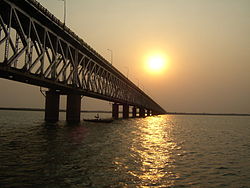Godavari Bridge
This article needs additional citations for verification. (April 2008) |
Godavari Bridge | |
|---|---|
 The Godavari Bridge across Godavari River | |
| Coordinates | 16°59′52″N 81°45′21″E / 16.99778°N 81.75583°E |
| Carries | Two lanes of Road and Single Railway line. |
| Crosses | Godavari River |
| Locale | Rajahmundry |
| Other name(s) | Rajahmundry-Kovur Bridge |
| Preceded by | Godavari Arch Bridge |
| Followed by | The Havelock Bridge |
| Characteristics | |
| Design | Truss Bridge |
| Total length | 2.7 kilometres (1.7 mi) |
| Longest span | 97.5 metres (320 ft) |
| History | |
| Engineering design by | Braithwaite, Burn & Jessop Construction Company |
| Opened | August 16,1974 |
| Location | |
 | |
The Godavari Bridge or Kovvur-Rajahmundry Bridge is a truss bridge spanning Godavari river in Rajahmundry, India. It is Asia's second longest road-cum-rail bridge crossing a water body, after the Sky Gate Bridge in Kansai International Airport, Osaka. It is second of the three bridges that span the Godavari River at Rajahmundry. The Havelock Bridge being the earliest, was built in 1897, and having served its full utility, was decommissioned in 1997. The latest bridge is the Godavari Arch Bridge, a bowstring-girder bridge, built in 1997 and presently in service.
The bridge is 2.7 kilometers long consisting of 27 spans of 91.4 m and 7 spans of 45.72 m of which 6 spans of 45.72m are in 6 deg. curve at long Rajahmundry end to make up for the built up area. The bridge has a road deck over the single track rail deck, similar to the Grafton Bridge in New South Wales, Australia. This bridge, in addition to Godavari Arch Bridge, has been widely used to represent Rajahmundry in arts, media, and culture. It is one of the recognised symbols of Rajahmundry.[1]
Geography
The road-cum-rail bridge is built across the Godavari River (largest river in South India at over 1,000 kilometres (620 mi) length) as it enters into the deltaic reach before debouching into the sea 60 kilometres (37 mi) downstream of the bridge, the second largest river in India. At the location of the bridge, near Rajahmundry, the river flows with a width of about 2.7 kilometres (1.7 mi), split in two channels with an island formation in between. The maximum discharge observed in the river is reported to be around 3 million m3/s and the maximum velocity of water flow as 5 metres (16 ft) per second
History
Construction
During the Third Five-Year plan doubling of railway track between Chennai-Howrah was planned. Most of the route had been doubled except the small stretch of track between Kovvur- Rajahmundry where a bridge had to be built to span the three kilometer long Godavari River. During 1964, the construction of second bridge across Godavari river at Rajahmundry was sanctioned as a part of doubling of track between Kovvur- Rajahmundry. But there had been a persistent demand from local population for construction of a road link between Kovvur- Rajahmundry, which would essentially link East Godavari and West Godavari districts. The Andhra Pradesh State Government came forward with the proposal to add a road deck over the rail bridge under construction as a part of doubling the railway track between Chennai-Howrah.[2]
It was commissioned by South Central Railway division of Indian Railways. Construction of the bridge began in early 1970s by Braithwaite, Burn & Jessop Construction Company, a group company of Bharat Bhari Udyog Nigam Limited. [3]. When completed it was Asia's longest rail -cum- road bridge.
It was inaugurated by the then President of India, Fakhruddin Ali Ahmed in 1977.
Sister Bridges
Old Godavari Bridge
The Old Godavari Bridge or the Havelock Bridge was built in 1900 by Mr.F.T.G.Walton, now decommissioned, this bridge has 56 spans and is 2754 m long. It was constructed with stone masonry and steel girders and certainly a marvel of British engineering. The New Godavari Bridge was made as a substitute for it.
Godavari Arch Bridge
Godavari Arch Bridge is the newest bridge constructed among the three. Constructed by the Hindustan Construction Company (HCC), this bridge is a modern day engineering feat. The bridge is made of bow string girder arches. The bridge is fit for 350 km/h rail services. The bridge was opened for rail traffic in 2003.
Panorama

See also
- List of road-rail bridges
- List of longest bridges in the world
- List of longest bridges above water in India
Gallery
-
Sunset at the Bridge
-
Sunset at the Bridge
-
Starting of the bridge. Notice the elevated road going over the bridge to join it.
-
Stretch of Godavari Bridge. This is only the half of the bridge
References
- ^ http://www.thehindubusinessline.in/2006/03/06/stories/2006030601050500.htm
- ^ R.R., Bhandari. Bridges: A Spectacular Feat of Indian Engineering (PDF).
- ^ "Structurae - Godavari Bridge". Structurae. Retrieved 9 June 2011.
{{cite web}}:|first=missing|last=(help)




